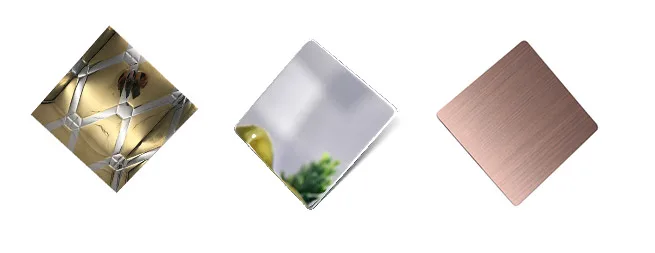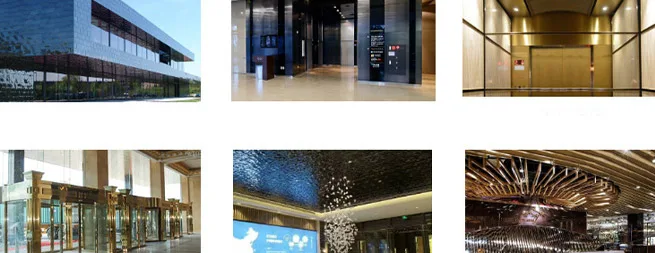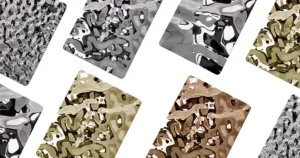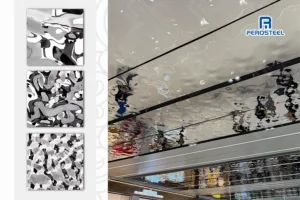Stainless steel sheets products are widely used across various industries due to their exceptional strength, corrosion resistance, and versatility. From construction to automotive manufacturing, stainless steel sheets are critical materials that drive the development of modern industries. This guide will provide an in-depth look at the types, manufacturing processes, benefits, applications, and future trends of stainless steel sheet products, giving you a thorough understanding of this high-performance material.
Table of Contents
- 1. What Are Stainless Steel Sheets
- 2. Types of Stainless Steel Sheets
- 3. Manufacturing Process of Stainless Steel Sheets
- 4. Surface Finishes of Stainless Steel Sheets
- 5. Key Applications of Stainless Steel Sheets
- 6. Thickness and Dimensions of Stainless Steel Sheets
- 7. Advantages of Using Stainless Steel Sheets
- 8. Comparison Between Stainless Steel and Other Metals
- 9. How to Choose the Right Stainless Steel Sheet
- 10. Cost Factors of Stainless Steel Sheets
- 11. Sustainability and Environmental Benefits of Stainless Steel
- 12. Maintenance and Care for Stainless Steel Sheets
- 13. Innovations and Developments in Stainless Steel Sheets
- 14. Global Market Dynamics and Trends for Stainless Steel Sheets
- 15. Future Outlook for Stainless Steel Sheets
- Frequently Asked Questions
- 1. What is the most common type of stainless steel sheet?
- 2. How do I maintain the surface of stainless steel sheets?
- 3. Can stainless steel sheets be used outdoors?
- 4. What thickness of stainless steel sheet is ideal for structural applications?
- 5. How is the price of stainless steel sheets determined?
- 6. Is stainless steel environmentally friendly?
1. What Are Stainless Steel Sheets
Stainless steel sheets are flat, thin pieces of metal primarily made from iron with at least 10.5% chromium content, which gives the material its corrosion resistance. Chromium forms a thin layer of chromium oxide on the surface, protecting the metal from rust and corrosion. This protective layer is self-healing, meaning that if damaged, it can regenerate in the presence of oxygen, ensuring long-lasting protection.
Because of their corrosion resistance, strength, and sleek finish, stainless steel sheets are used across industries such as construction, appliances, food processing, and chemical equipment. Whether for structural or decorative purposes, stainless steel’s combination of function and aesthetics offers limitless possibilities for modern designs.

2. Types of Stainless Steel Sheets
Stainless steel is classified into several types based on its microstructure and performance, with each type offering distinct advantages for different applications.
2.1 Austenitic Stainless Steel
The most common type, austenitic stainless steel, contains high levels of chromium and nickel, providing excellent corrosion resistance and ductility. Austenitic stainless steel is non-magnetic and is widely used in food processing, kitchenware, and chemical facilities. Grades 304 and 316 are among the most popular.
2.2 Ferritic Stainless Steel
Ferritic stainless steel offers good corrosion resistance and oxidation resistance at a lower cost. It contains higher levels of chromium and has magnetic properties, making it suitable for automotive parts and interior decoration. The 430 grade is a common ferritic stainless steel.
2.3 Martensitic Stainless Steel
Known for its high strength and hardness, martensitic stainless steel is widely used in the production of knives, surgical instruments, and engineering equipment. Unlike austenitic steel, martensitic stainless steel can be heat-treated to adjust hardness. Common grades include 410 and 420.
2.4 Duplex Stainless Steel
Duplex stainless steel combines the best properties of austenitic and ferritic steels, offering higher strength and superior corrosion resistance, especially in environments that are highly corrosive or under stress. Duplex 2205 is a widely used grade in marine and chemical industries.
3. Manufacturing Process of Stainless Steel Sheets
Stainless steel sheets are produced through two main processes: hot rolling and cold rolling.
3.1 Hot Rolling Process
Hot rolled stainless steel sheets are made by rolling steel at high temperatures, above its recrystallization point. Hot rolling allows the steel to be easily shaped, but the resulting surface is rough. Hot rolled sheets are commonly used in applications where surface finish is not critical, such as construction materials and containers.
3.2 Cold Rolling Process
Cold rolled stainless steel is produced by further rolling hot rolled sheets at room temperature, improving their surface smoothness and mechanical properties. Cold rolling results in sheets with higher tensile strength and a more refined surface finish, making them ideal for applications where surface quality is important, such as appliances, precision instruments, and decorative materials.
4. Surface Finishes of Stainless Steel Sheets
The surface finish of stainless steel sheets enhances their appearance and functionality. Common finishes include:
4.1 2B Finish
A common, smooth matte finish with moderate reflectivity, the 2B finish is widely used in industrial and chemical applications where appearance is less important.
4.2 Brushed Finish
Brushed stainless steel has a unique textured grain, providing a soft sheen. It’s widely used in household appliances, elevators, and architectural design for its attractive look and ease of maintenance.

4.3 Mirror Finish
Mirror-finish stainless steel is highly polished to achieve a reflective surface, often used in decorative applications such as interior décor, automotive trim, and elevator panels.
4.4 Embossed Finish
Embossed stainless steel sheets feature raised or recessed patterns, enhancing their decorative appeal while also improving functionality in flooring or as decorative panels.
5. Key Applications of Stainless Steel Sheets
Due to their versatility, stainless steel sheets are used in a wide range of industries. Some key applications include:
5.1 Automotive Industry
Stainless steel sheets are commonly used in automotive exhaust systems, trim, and interior components due to their high-temperature resistance and corrosion-resistant properties, extending vehicle life and improving aesthetics.
5.2 Construction and Architecture
In the construction industry, stainless steel sheets are used in cladding, roofing, and interior décor such as railings and elevator panels. Their corrosion resistance and sleek appearance make them ideal for modern building designs.
5.3 Appliances
The durability and clean appearance of stainless steel make it a popular material in the appliance industry for products like refrigerators, dishwashers, and ovens, offering both style and functionality.
5.4 Food and Beverage Processing
Stainless steel’s non-toxic and easy-to-clean properties make it the go-to material for food processing equipment, countertops, and storage tanks, ensuring food safety and hygiene standards are met.

6. Thickness and Dimensions of Stainless Steel Sheets
The thickness of stainless steel sheets is typically expressed in gauges, with higher numbers indicating thinner sheets. For example, a 24-gauge stainless steel sheet is thinner than a 12-gauge sheet.
Common standard sizes include:
- 36″ x 96″ (914mm x 2438mm)
- 48″ x 120″ (1219mm x 3048mm)
Custom sizes are also available to suit specific project needs. Choosing the right thickness and size depends on the intended use and strength requirements of the application.
7. Advantages of Using Stainless Steel Sheets
7.1 Outstanding Corrosion Resistance
Thanks to the protective chromium oxide layer, stainless steel can resist corrosion even in harsh environments, making it ideal for use in marine and chemical settings.
7.2 Strength and Durability
Stainless steel sheets offer high strength and durability, capable of withstanding heavy loads and extreme temperature variations, making them suitable for structural applications in exposed environments.
7.3 Easy to Clean and Maintain
Stainless steel’s smooth surface makes it easy to clean, preventing the buildup of dirt and bacteria, which is particularly important in food processing and healthcare environments.
7.4 Aesthetic Appeal
With a sleek, modern appearance and various surface finish options, stainless steel sheets are a favorite in architecture and design, adding a contemporary and professional look to any project.
8. Comparison Between Stainless Steel and Other Metals
Stainless steel is often compared with other metals like aluminum and carbon steel. Here are the key differences:
- Stainless Steel vs Aluminum: Stainless steel is stronger and more corrosion-resistant than aluminum, but it is also heavier. Aluminum is lightweight and more suitable for applications requiring reduced weight.
- Stainless Steel vs Carbon Steel: Carbon steel is cheaper and stronger than stainless steel but lacks corrosion resistance, making it less suitable for applications exposed to moisture or chemicals.
9. How to Choose the Right Stainless Steel Sheet
When selecting stainless steel sheets for your project, consider the following:
- Environmental Conditions: If the sheet will be exposed to chemicals or high humidity, choose a more corrosion-resistant grade like 316 stainless steel.
- Surface Finish: Choose a finish that meets your aesthetic and functional needs. For example, brushed or mirror finishes are ideal for decorative applications, while 2B finishes work well for industrial uses.
- Thickness and Strength: For structural applications, opt for thicker sheets to ensure better load-bearing capacity. For lighter, decorative uses, thinner sheets may suffice.
10. Cost Factors of Stainless Steel Sheets
The cost of stainless steel sheets depends on several factors, including:
- Material Grade: Higher-grade stainless steel, such as 316, typically costs more than lower-grade 304, due to enhanced corrosion resistance and nickel content.
- Surface Finish: Finishes like polished or brushed surfaces tend to cost more than basic 2B finishes due to the additional processing involved.
- Market Demand: Global fluctuations in the prices of raw materials like nickel and chromium directly impact the price of stainless steel sheets.
11. Sustainability and Environmental Benefits of Stainless Steel
Stainless steel is 100% recyclable, making it one of the most sustainable materials available. Even after multiple recycling processes, stainless steel retains its properties, reducing waste and minimizing the need for new raw materials, enhancing its environmental friendliness.
12. Maintenance and Care for Stainless Steel Sheets
Maintaining stainless steel sheets is relatively easy with proper care. Here are a few tips:
- Cleaning: Use mild soap and water with a soft cloth to clean the surface. Avoid abrasive tools that may scratch the surface.
- Protection: To prevent water spots and fingerprints, use specialized stainless steel cleaners and polish, especially in areas where the material is frequently touched.
13. Innovations and Developments in Stainless Steel Sheets
Recent innovations in stainless steel sheet products include anti-bacterial stainless steel for medical use and nano-coating technologies, which further enhance corrosion resistance. Additionally, low-carbon manufacturing processes are being developed to reduce the environmental impact of stainless steel production.
14. Global Market Dynamics and Trends for Stainless Steel Sheets
China, Japan, and Europe are key producers and consumers of stainless steel sheets. With the rise of green buildings, smart manufacturing, and electric vehicles, the demand for stainless steel sheets is projected to grow, with a strong upward trend expected over the coming years.
15. Future Outlook for Stainless Steel Sheets
The future of stainless steel sheets is bright, with new applications emerging in fields such as green energy, smart buildings, and advanced manufacturing. As technology continues to evolve, the corrosion resistance, workability, and eco-friendly properties of stainless steel will be further enhanced, driving its use across more industries.
Frequently Asked Questions
1. What is the most common type of stainless steel sheet?
304 stainless steel is the most common type, known for its excellent corrosion resistance and versatility across many industries.
2. How do I maintain the surface of stainless steel sheets?
Regularly clean the surface with mild soap and water, avoid using harsh chemicals, and dry the surface to prevent water spots.
3. Can stainless steel sheets be used outdoors?
Yes, especially grade 316 stainless steel, which offers superior corrosion resistance in outdoor environments exposed to saltwater and high humidity.
4. What thickness of stainless steel sheet is ideal for structural applications?
For structural applications, a thickness of 10-gauge or lower is recommended to ensure adequate strength and support.
5. How is the price of stainless steel sheets determined?
The price is influenced by factors such as material grade, surface finish, thickness, and market conditions for raw materials like nickel and chromium.
6. Is stainless steel environmentally friendly?
Yes, stainless steel is a recyclable and sustainable material, making it an eco-friendly choice that retains its performance after multiple recycling processes.



